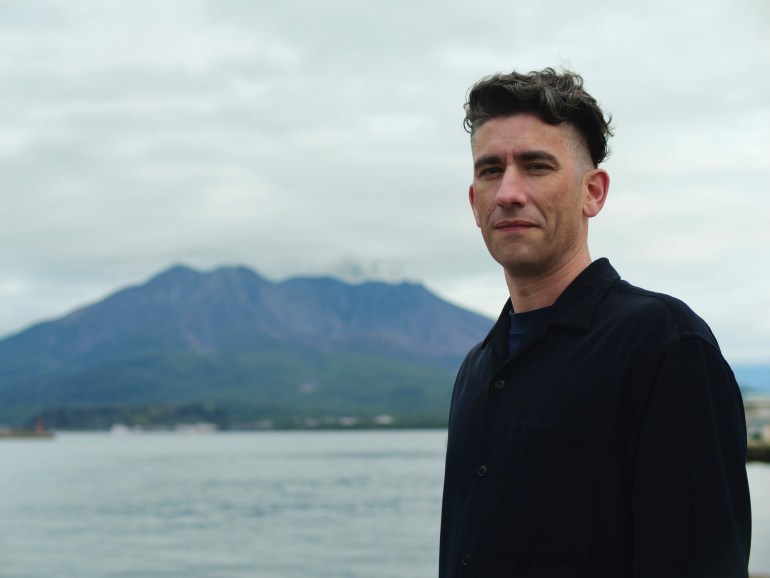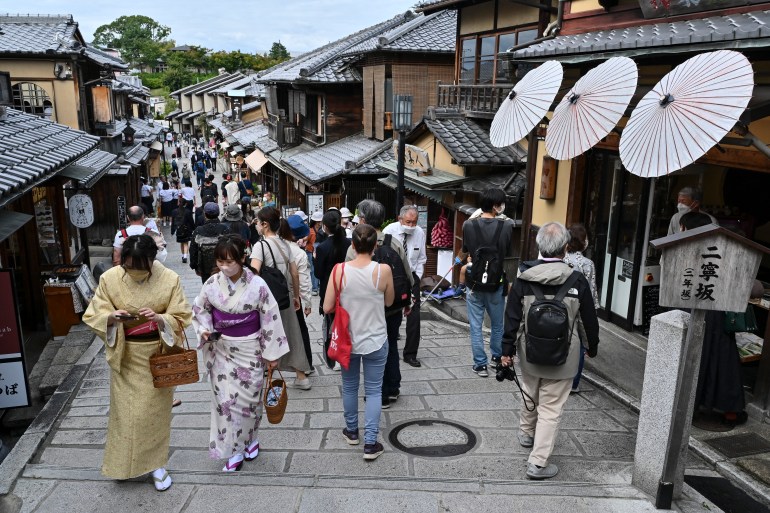Tokyo, Japan – When Paul Christie started conducting tours on Japan’s Nakasendo, an old trade route along the post towns of Nagano Prefecture’s Kiso Valley, few travellers frequented the trail.
Christie, who has lived on and off in Japan since the late 1980s, viewed the route as a great opportunity for tourists to see a more authentic side of Japan, allowing them to explore the country’s history, nature and geography on foot.
Since taking over as CEO of tour operator Walk Japan in 2002, Christie has been on a mission to spread tourists more evenly across the archipelago.
“We’ve been doing this for 20 years and we tend to go to places that are not touristy, so we’re teasing out the interesting parts of Japan,” the United Kingdom native told Al Jazeera.
“This addresses the problems Japan is experiencing with ‘overtourism’.”

“Overtourism” was a common talking point in Japan’s tourism industry before the COVID-19 pandemic.
After eight consecutive years of inbound growth, Japan received a record 32 million visitors in 2019.
But the rising tide did not raise all boats. Most travellers flocked to the Golden Route, running from Tokyo through the Osaka-Kyoto-Kobe conurbation, putting historical districts, Shinto shrines, Buddhist temples and popular museums under strain.
Since Japan lifted its pandemic-era border restrictions in October last year, concerns about unsustainable tourism have returned.
Visitors have rushed back in droves: 2.3 million foreign tourists arrived in July, the highest figure for any month since 2019.
China’s decision last month to lift its three-year ban on group tours to Japan is expected to result in a further spike in arrivals.
In 2019, 9.2 million Chinese tourists travelled to Japan, accounting for nearly one-third of all visitors, spending 1.8 trillion yen ($12.2bn) in the process.
“Our head office is located in the centre of Kyoto and we feel there are as many tourists as before COVID,” Hiroshi Kawaguchi, the general manager at tour operator Oku Japan, told Al Jazeera.
“This is a similar situation where major sightseeing spots are overcrowded and public buses are lining up.”
Though Kawaguchi says his company’s vision is not focused on alleviating overtourism, Oku Japan’s business model is attuned to such concerns.
“The main part of our itineraries are off the beaten track,” Kawaguchi told Al Jazeera.
“More importantly, every tour we offer includes the element of community interactions… We call these experiences fureai, and this is particularly important not only for the enjoyment of clients but also the local community.”

Tour operators focused on less-explored regions also believe in the power of tourism to have a positive impact on rural communities and spur chiho-sosei, or regional revitalisation.
In 2007, Walk Japan launched the Community Project to reinvigorate two neighbouring valleys on the Kunisaki Peninsula, where the company is based.
Alongside conducting group tours in the region, Walk Japan helps with farming, education, real estate development and job creation.
Revitalisation is “part of the company DNA,” Christie said.
“We want to provide an example of what’s possible and perhaps inspire others.”
As Japan’s population greys, many small villages are on the brink of extinction. For such communities, tourism can be a welcome and much-needed rejuvenating force.
“With the right support, some communities genuinely want [tourists] to experience their hospitality and their local lifestyles and find out about their region, as long as they aren’t overwhelmed by visitors and the quality of life isn’t degraded,” Alex Bradshaw, founder and chief consultant at travel and tourism consultancy Gotoku, told Al Jazeera.
“Even if a village doesn’t survive into the future, the fact that it’s been remembered by somebody is incredibly powerful; that people lived here and they had this lifestyle and we shared a little time together. That kind of human interaction is very important.”

Overtourism is not restricted to Japan’s urban areas.
Rural World Heritage sites, subtropical islands, popular hiking trails and national parks have also been negatively affected.
Fuji-Hakone-Izu, for example, receives nearly half of all national park visitors in Japan, owing to its proximity to Tokyo and as the site of Mount Fuji.
Michelle Lyons, founder of Point North, a specialist branding firm supporting businesses passionate about Japanese culture, is working on a campaign to spread tourism – and its economic benefits – more equitably among Japan’s 34 national parks.
“I wanted to find a way to promote all the parks as though it’s a network of destinations that are all equal to each other,” Lyons told Al Jazeera.
“And by presenting them in this way I’m hoping the more popular parks will help raise the profile of the less popular parks.”
Lyons is developing collectable pins and patches for each park and a trading card game. She wants these collectable souvenirs to showcase the individual merits of each park and serve as educational tools.
“The management of the parks is really fragmented, so it’s difficult for them to coordinate their efforts… There needs to be a series of different solutions that creates value for the unique groups involved; a blanket approach isn’t going to work,” she said.
“In terms of increasing expenditure in the parks, gift shops could play a big part in that if they’re more strategic with what they’re selling, and think about what tourists actually want and find appealing.”
Stereotypical images
It’s a common refrain in the industry that Japan does not understand how to market itself to foreign travellers but Bradshaw thinks Western media is also at fault for presenting stereotypical images of the country.
“I see how Japan is presented and I’m kind of confused by it. I just wonder what part of Japan that is, because they do rely on the kitsch, the odd side of it, or culture tropes… It’s all maid cafés, geisha, tea ceremonies and ninja,” he said.
“It would be my hope that people would find a deeper side of Japan. But I understand why that is difficult for the tourism industry as well. When you’ve got to prioritise what sells as opposed to what’s authentic and necessarily good for regional communities.”
Some areas have implemented initiatives to specifically tackle overcrowding.
Kyoto, known as Japan’s cultural capital, is set to abolish its One-Day Bus Pass for tourists, sales of which will cease in October.
Iriomote, widely feted as the most beautiful of the Ryukyu Islands, has limited the number of daily visitors to 1,200.
In Yamanashi Prefecture, the local government has considered restricting the number of hikers on Mt Fuji’s Yoshida trail if it becomes too congested.
Last month, Prime Minister Fumio Kishida announced that the government would devise nationwide countermeasures to mitigate overtourism this autumn.

Kumi Kato, a tourism professor at Wakayama and Musashino universities, said the government has made moves in the right direction – such as organising cross-ministry meetings on spreading the benefits of tourism – but there is much work to be done.
“Destination wellbeing should be the goal and benchmarking concept,” Kato told Al Jazeera.
“Promoting the night and early morning economy and secondary destinations will disperse tourism into regional areas but that alone cannot lead to successful regional tourism.”
“It’s critical that the target should be clearly set… high-end tourists, or tourists with wealth, are often talked about, but it should not be misunderstood that only wealthy tourists are valuable,” Kato added.
“Value should be added to high-quality products and authentic experiences [which will] raise visitor per spending rather than increase numbers. The government does set a target stay – number of days – and spending per visitor, but strategically ‘what kind of tourists’ should be clearer.”
Sumber: www.aljazeera.com
 Skip to content
Skip to content

